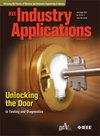连接器,连接器,连接器:它们不都是一样的吗?
IF 4.5
2区 工程技术
Q2 ENGINEERING, ELECTRICAL & ELECTRONIC
引用次数: 0
摘要
在工业和商业设施中,使用非额定的连接器和不正确的安装是导致电源中断的原因。为提高配电系统的可靠性和性能提供了合理的选型和安装方法。任何电气系统的目标都是在系统的生命周期内正常运行。本文回顾了在整个电气系统中用于不同功能的电连接器的类型和技术特性,例如接地,键合和电源连接。环境方面的考虑,如直接埋葬,潮湿的位置,并解决了阳光抗性。介绍了新的连接器应用,如线路侧服务额定值。本文还讨论了超过1000伏应用的连接器的特性和安装实践。概述了连接器安装信息,例如扭矩要求、细绞合导体影响、根据美国国家电气制造商协会(NEMA)标准的孔间距指南、电压限制和温度额定电容量影响。本文章由计算机程序翻译,如有差异,请以英文原文为准。
Connectors, Connectors, Connectors: Aren't They All the Same?
Using a connector not rated for the application and improper installation is a cause of power interruption in industrial and commercial facilities. This paper provides a primer for proper selection and installation practices to improve electrical distribution system reliability and performance. The goal of any electrical system is to perform functionally for the life of the system. This paper reviews the types and technical characteristics of electrical connectors that are used for distinct functions within the overall electrical system, such as grounding, bonding, and power connections. Environmental considerations such as direct burial, wet locations, and sunlight resistance are addressed. New connector applications such as line side of the service ratings are introduced. The paper also addresses the characteristics of connectors and installation practices for applications over 1000 Volts. Connector installation information, such as torque requirements, finely stranded conductor impacts, hole spacing guides per the National Electrical Manufacturers Association (NEMA) standard, voltage limitations and temperature rating ampacity impacts are outlined.
求助全文
通过发布文献求助,成功后即可免费获取论文全文。
去求助
来源期刊

IEEE Transactions on Industry Applications
工程技术-工程:电子与电气
CiteScore
9.90
自引率
9.10%
发文量
747
审稿时长
3.3 months
期刊介绍:
The scope of the IEEE Transactions on Industry Applications includes all scope items of the IEEE Industry Applications Society, that is, the advancement of the theory and practice of electrical and electronic engineering in the development, design, manufacture, and application of electrical systems, apparatus, devices, and controls to the processes and equipment of industry and commerce; the promotion of safe, reliable, and economic installations; industry leadership in energy conservation and environmental, health, and safety issues; the creation of voluntary engineering standards and recommended practices; and the professional development of its membership.
 求助内容:
求助内容: 应助结果提醒方式:
应助结果提醒方式:


